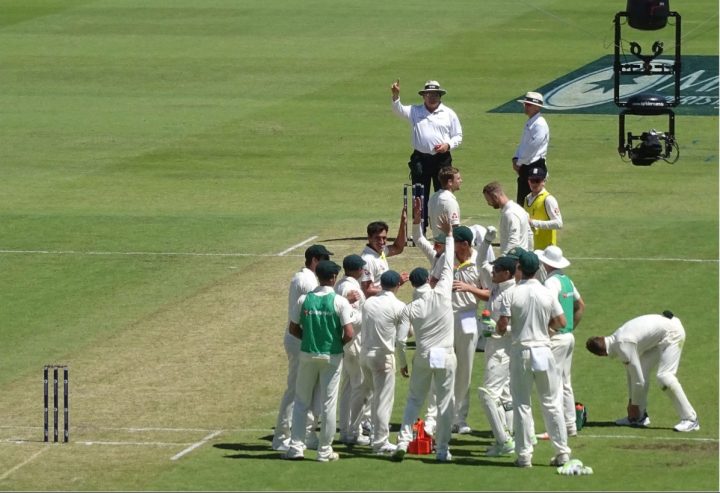Here’s the second part of Shaun Edward’s epic Ashes preview …
Two: Batting Long.
Or, if you’re being less kind, batting dull.
In the last victorious Ashes series, the main plan was to bat once, and bat long. It worked, England winning all three of their matches by an innings, having racked up scores of 620, 513 and 644. Even in the drawn opener at the Gabba they saved the game with a truly monstrous 517-1 declared.
I’ll be honest: when Andrew Strauss hung up the boots and unlaced his bat for the last time, I was very concerned about the fragility of the English batting line up. Though the skipper’s form was obviously on the wane, he and Cook still walked out to the middle with an air of authority. With the big man gone, Cook and Jonathan Trott seemed like they were the only ones who were always up for a fight.
Unfortunately, my suspicions were confirmed against the Proteas. With Vernon Philander able to conjure magic balls at will to defeat Cook and Dale Steyn targeting Trott’s front pad with the rage of a scorned lover, it became apparent that when numbers two and three went quickly, England had to rely on a spark of genius to stay in the game. At Headingley, they were given one: at the Oval and at Lords they were not so lucky. Jonny Bairstow was superb in the final, but at that young age England no-one could expect him to reach those standards regularly.
In Ian Bell and Kevin Pietersen, England had an abundance of class. What they needed were scrappers.
Scrappers is what they found.
I’m going to make a bold assertion: Nick Compton and Joe Root will both finish their careers with test averages of fifty or more. It’s entirely possible that Root could end up breaking the English record for the most test centuries. And not the one already set by Graham Gooch, but the one that has yet to be set by the current skipper.
Some players simply look the part when they reach international level. There are nerves, yes, but no visible fears. They simply go out there and play their game; the same game that has got them there in the first place. Marcus Trescothick was one, Graham Thorpe another, Andrew Strauss too.
Both Compton and Root, though they have only played four tests and one test respectively, seriously look the business. Both treat their wicket like an addict treats their only remaining fix: it is the only thing they care about, and they will sacrifice a great deal to keep it safe.
Both have arrived in the England team via completely different routes, which does the selectors credit. It does Compton, credit, too. He earned his place in the test side by scoring so many runs that it was impossible to ignore him any further. In a domestic season where wickets fell like the wheat and the Duke’s ball swung to the tune of even the most average fast bowler, Compton scratched, clawed and chiselled his way to an average of 99.60.
Unlike Compton, Root would have been in the England side sooner or later, regardless of his county form. To his credit, the young Yorkshireman didn’t let it bother him. At the Aegeas Bowl in July, Root faced a strong Hampshire attack under grey skies on a wicket that resembled a lawn. He nearly carried his bat for 222 runs from a team total of 350-9*. The next highest individual score on his team was 37.
Compton’s series against India might not have been jaw-dropping. His highest score was 57 and he averaged a little over 34. However, he put on four opening stands of at least fifty with Cook, the highest of which was 166 at Kolkata. An opening pair who put on serious stands are important, and with Trott at three, the England side look like they could stick on 150 for the first two wickets on a regular basis.
Root, for his part, contributed 93 runs from two innings in his only test match so far. In both that match and the ODI series, he has looked confident and composed. In an article for The Times (behind the paywall unfortunately), Michael Atherton described Root as the first cricketer to receive the ‘complete education’ from the ECB. Although this was his first proper tour with England, the young batsmen has already played four day games in every test playing nation, and is far more familiar with Indian conditions than someone like Steve Waugh would have been before he went out there with Australia. It is this experience, so far ahead of any other debutant, that will make him a success. It’s why, in a second innings block session that Paul Collingwood would have been proud of, he looked so much the part.
The Australian attack might not be as impotent as they were in the previous series down under. Peter Siddle (a bowler I rate highly) has always had that bit of ticker, but now he has a dangerous outswinger to go with it. Ben Hilfenhaus will have fond memories of English conditions having been the highest wicket taker in the 2009 series. Meanwhile, several of the new Aussie quicks look capable of gaining edges and knocking over poles, especially on a wicket like Trent Bridge (where the first test takes place). Mitchell Starc, in particular, looks a handful, and England have never seemed comfortable in dealing with genuine left arm swing.
However, battlers like Cook, Compton, Trott and Root will enable Pietersen, Bell and Prior (not to mention Swann and Broad) to go on the counter attack. This time last year, a bad day for Cook and Trott together often meant a batting collapse. Now, there are two more players ready to take up the mantle of blocking for Harry, England and St George.
Shaun Edwards









